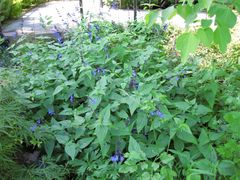Salvia guaranitica
| Salvia guaranitica subsp. var. | ||||||||||||||||||||||||||||||||||||||||||||||||||||||||
|---|---|---|---|---|---|---|---|---|---|---|---|---|---|---|---|---|---|---|---|---|---|---|---|---|---|---|---|---|---|---|---|---|---|---|---|---|---|---|---|---|---|---|---|---|---|---|---|---|---|---|---|---|---|---|---|---|

|
|
| ||||||||||||||||||||||||||||||||||||||||||||||||||||||
| ||||||||||||||||||||||||||||||||||||||||||||||||||||||||
Salvia guaranitica (Anise-scented sage or Hummingbird sage) is a species of sage native to South America, including Brazil, Paraguay, Uruguay, and Argentina.
It is a perennial subshrub growing 1-3 m tall. The leaves are ovate, 4-13 cm long, mint green, and anise-scented when crushed. The inflorescences are up to 25 cm long, with each flower 3-5 cm long in varying shades of blue, with a dark basal calyx 10-12 mm long. Flowering begins in mid summer and continues till mid autumn.
Cultivation
Salvia guaranitica is a popular ornamental plant in mild areas where the temperature does not fall below −12 °C. It grows in either full or three quarter sunlight, in well drained soil.
Numerous cultivars have been selected, including 'Argentine Skies' (pale blue flowers), 'Black and Blue' (very dark violet blue calyx), 'Blue Enigma', 'Blue Ensign' (large blue flowers), and 'Purple Splendor'.
Propagation
Pests and diseases
Species
Gallery
If you have a photo of this plant, please upload it! Plus, there may be other photos available for you to add.
-
photo 1
-
photo 2
-
photo 3
References
- Standard Cyclopedia of Horticulture, by L. H. Bailey, MacMillan Co., 1963
External links
- w:Salvia guaranitica. Some of the material on this page may be from Wikipedia, under the Creative Commons license.
- Salvia guaranitica QR Code (Size 50, 100, 200, 500)

